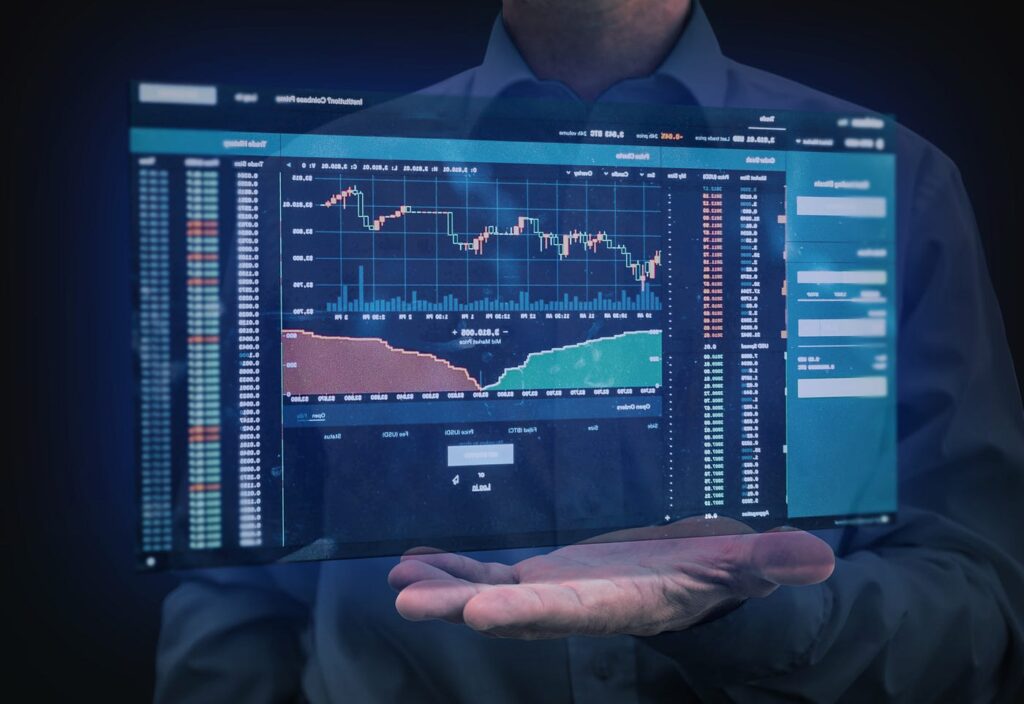How Technical Analysis in Forex Trading Shapes Decisions?
Thanks to technical analysis in forex trading, investors try to predict future trends in price movements in the market. Thanks to technical analysis, investors can make high-rate predictions about future trends by looking at past price movements and trading volume in any currency.
Forex investors can make their trading strategies more profitable thanks to technical analysis in forex trading. Support and resistance levels are determined more accurately thanks to these tools. In this way, they have an idea about when to enter and when to exit the market.
By avoiding emotional decisions, it is easier to apply forex investment strategies by risk management thanks to technical analysis in forex trading. Thanks to conscious trading moves, forex investors minimize risks and maintain their financial stability.
What Is Technical Analysis In Forex Trading And How Does It Work?

Technical analysis in forex trading is basically examining the past price movements of foreign exchange units in the markets, making more realistic predictions about future trends, and shaping investment strategies according to these predictions.
Technical analysis in forex trading is managed with graphs, indicators, and many tools. With technical analysis, future assumptions are made based on past trends in prices.
In forex markets, graphs and indicators that present the past trends of a currency unit as data in an understandable way help investors. Instead of longer-term time frames, even short time scopes such as one hour are analyzed.
Therefore, technical analysis tools are the appropriate choice for short-term profits. Some important concepts and factors for technical analysis in forex trading can be listed as follows:
- past prices
- trends
- support levels
- resistance levels
- trading volume
For short-term trading and quick decisions, technical analysis tools will be more profitable for forex investors. Therefore, investors who aim to make a profit in the short term in forex markets manage their investments through technical analysis indicators and graphs.
Benefits Of Using Technical Analysis In Forex Trading Decisions
As with every type of investment, there are many benefits to using analysis tools in forex markets. Especially technical analysis in forex trading offers many commercial advantages.
If you want to quickly recognize the trends of a currency you follow in the market, technical analysis will be a great choice for you. In addition, technical analysis is essential for forex investors to manage risks more accurately and determine the right entry and exit times.
Thanks to technical analysis in forex trading, investors avoid emotional reactions and speculations. Making decisions based on objective data will protect your financial stability.
In addition to these, I can claim that technical analysis tools are also very useful for forex investors who want to make short-term profits. Because it is easier to give fast and accurate reactions to instant changes thanks to technical analysis tools.
For this reason, even beginner forex investors use technical analysis tools when they want to evaluate their assets with different currencies.
Common Tools For Technical Analysis In Forex Trading
There are some common tools to successfully apply the most common type of analysis, technical analysis in forex trading. With these tools, forex investors analyze the markets more easily. The most commonly used technical analysis in forex trading tools can be listed as follows:
- RSI: Relative Strength Index
- MACD: Moving Average Convergence Divergence
- Bollinger Bands
With these tools, market trends, overbought, or oversold times are determined in advance. Although intermediate and advanced forex investors generally use tools such as RSI, MACD, and Bollinger Bands more efficiently, beginner-level investors can also try to learn these tools with the help of demo accounts.
In addition to these tools, charts, and trading volume are also some of the critical factors of the technical analysis in the forex trading process.
How Does Technical Analysis Help Identify Forex Trading Trends?
The basic function of technical analysis in forex trading is to determine market trends for forex investors. So how can trends be determined with technical analysis tools? The simplest answer to this is to examine past data.
The appreciation or depreciation of a currency unit in the forex markets is examined as data on past trends. The rise of the market is called bullish, and the fall is called bearish. Bullish and bearish situations are trends that have been repeated in the past.
Therefore, it is likely to enter similar trends in the future. In addition, support and resistance levels are determined through technical analysis in forex trading. In this way, forex investors determine potential turning points more accurately.
Thanks to all these tools, forex investors can be more strategic when making investment decisions. The most critical skill is to read these analyses correctly and make the right move at the right time.
Comparing Technical And Fundamental Analysis In Forex Trading

While technical analysis in forex trading is based on analyzing the past trends of the currency chosen by investors, macroeconomic factors such as economic indicators, interest rates, and inflation rates are effective in the fundamental analysis method.
The most common types of analysis in forex markets are divided into two technical and fundamental analysis methods Fundamental and technical analysis methods are used in many traditional investment models.
Investors who aim to make shorter-term profits benefit from technical analysis tools, while those who aim for long-term profits are interested in fundamental analysis methods and tools.
Direct changes in price movements can be observed with technical analysis methods. However, in fundamental analysis methods, not only the forex market but also market sentiment and economic conditions within the entire economic ecosystem are effective.
However, today, successful forex investors use both technical and fundamental analysis tools together.
Mistakes To Avoid When Using Technical Analysis In Forex Trading
Many investors, both professional and beginner level, can make mistakes in the technical analysis in the forex trading process. Common mistakes made by those who manage their investments with technical analysis tools in today’s markets can be listed as follows:
- Overconfidence
- Using wrong indicators
- Emotional decisions
- Using too many indicators
Overconfident investors can make commercial moves contrary to the dynamics of forex markets and experience losses. In addition, not every indicator may be the right tool for every market. Evaluating wrong indicators and examining many different indicators can be confusing.
In addition, emotional reactions and speculations are valid in forex markets, almost as in the investment model. You should avoid overreacting to short-term forex market fluctuations.
Common characteristics of those who manage successful and commercially profitable investment projects are generally using fundamental and technical analysis methods together and avoiding emotional decisions.
How To Combine Technical Analysis With Risk Management In Forex
You should apply risk management strategies no matter what market you are managing an investment project in. Technical analysis in forex trading and risk management are not independent strategies.
Investors with profitable investment portfolios in forex markets use these two types of strategies together. When trading in forex markets, investors can determine support and resistance levels with technical analysis tools and apply stop-loss and take-profit orders more accurately.
In this way, technical analysis and risk management are applied together, minimizing potential losses. No matter what level of forex investor you are, you should consider the risk/reward ratio.
Forex investors are likely to lose money in the medium and long term if they neglect the risk/return ratio in a transaction and make transactions contrary to risk management. However, this will not happen if they trade in a manner determined by technical analysis.
For this reason, you can continue your investments in a disciplined manner by risk management with technical analysis tools that examine objective data.
The Role Of Charts In Technical Analysis For Forex Trading
Charts are evaluated to be able to apply technical analysis methods in many different investment models. Charts are needed for the most efficient management of technical analysis in forex trading. Thanks to charts, forex investors can visually perceive price movements and trading volume.
While examining the past value differences of a currency unit can be a complex process, technical analysis becomes more practical with more easily understandable visuals thanks to charts. The types of charts that investors most frequently browse in forex markets today can be listed as follows:
- Line chart
- Bar chart
- Candlestick charts
Forex investors determine support and resistance levels thanks to line and bar charts. In addition, candlestick charts allow forex investors to psychologically grasp market dynamics more quickly.
For example, ADX is also a common indicator. The fact that the ADX indicator is rising indicates that there is a trend. However, it does not provide information about the direction of the trend. A falling ADX gives an idea that the market is horizontal.
Based on this, it would be healthy to use trend indicators such as parabolic sar, moving averages, macd, and cci during periods when ADX is rising.
In periods when ADX is falling and moving horizontally, the use of oscillator type indicators such as Rsi and Stochastic, which move between two bands and show overbought-oversold, will benefit traders in the decision-making process.
In addition, it is seen that the ADX rising above the 20-25 level indicates a trending market, while the ADX moving below 20-25 indicates a horizontal market.
Key Indicators For Effective Technical Analysis In Forex Markets

For technical analysis in forex trading to be applied effectively, some indicators are frequently used. These indicators, which are indispensable for technical analysis, can be listed as follows:
- RSI
- MACD
- Fibonacci Retracements
- Bollinger Bands
With these key indicators, investors identify overbought and oversold areas. These indicators are also useful for predicting possible turning points.
With RSI, it is possible to determine whether any forex market product is overbought or oversold, while market momentum can be understood with the MACD indicator.
The MACD indicator provides investors with trading decisions based on the relationship between two separate moving averages. The first of these moving averages is a long-term, twenty-six-day exponential moving average, and the second is a twelve-day short-term exponential moving average.
The MACD indicator is found by subtracting the long-term exponential moving average from the short-term exponential moving average. There are basically three methods used when using the indicator to make trading decisions.
The first of these is; When the MACD line crosses the signal line from bottom to top, it is a “Buy” signal, and when it crosses from top to bottom, it is a “Sell” signal.
However, the location of the intersection is also important. In other words, if the buy signal is formed well below the zero line, in other words, in the oversold region, it is a strong buy signal and a long price increase is expected.
Similarly, when the sell signal is given in the upper parts on the positive side of the axis (overbought region), it is a sign that the price decline will continue for a long time.
In other words, according to this method, a healthy buy signal is given when the MACD breaks the signal line from below in the negative region, while a healthy sell signal is given when the MACD cuts the signal line from above to below in the positive region.
Another point to consider when using these types of indicators is the compatibility between the indicator and the price chart. If the price chart makes a higher peak than the previous one, but the MACD indicator cannot do this, it is expected that prices will fall and this event is a sell signal.
The opposite of this situation, that is, if the price chart tends to bottom at a lower level than the previous level, but the new bottom is formed higher than the previous one in the MACD indicator, this is interpreted as prices will rise and is considered a buy signal.
How Technical Analysis Shapes Short-Term Forex Trading Strategies
There are basically two different analysis methods in forex markets. Technical analysis methods are suitable for short-term forex strategies. Fundamental analysis methods are a longer-term investment type that also takes into account macroeconomic factors.
Thanks to technical analysis, forex investors have the chance to observe short-term price movements. Trading opportunities for a few minutes or hours can be reached with technical analysis methods.
Although it is riskier than forex strategies managed with fundamental analysis methods, it is also possible to make a profit with technical analysis methods.
A forex investor can more accurately follow and detect dynamics such as trading volume, trend reversals, and price movement speed thanks to technical analysis in forex trading.
Technical analysis tools are the best solution for short-term profit targets where quick decisions need to be made.
See you in the next post,
Anil UZUN
